top of page
Wicked Tiny House - Tiny House Hunters
Wicked Tiny House - Finish Work
First up for interior finishes, putting up the cedar tongue and groove (T&G) walls! The cedar was milled in Oakfield, Maine and I got a great deal by getting it directly from the mill. The T&G was "camp grade", so it was knotty and had "character". The first step was prepping the boards by sanding with 80 grit, 150 grit, and 220 grit, which was time consuming and messy. Then wood conditioner, natural stain, one coat of poly, and then sanding again with 220 grit. The final coat of poly will go on once the boards are installed. I started installation with an easy section, the small "nook" wall at the back of the house. It looked great, and I was super happy with the look. From there, I continued along the kitchen wall, and eventually up to the ceiling. Next was the loft, and finally the bathroom, kitchen, and finishing the living area. Because the wood was camp grade, many of the pieces were not perfectly straight and required some brute force to get lined up.
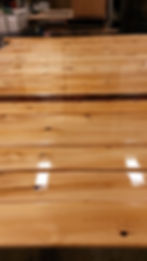
20160123_173827
Cedar T&G after the first coat of poly
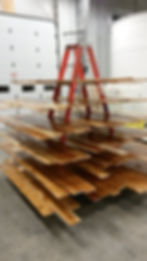
20160123_173849
T&G drying rack

60
First wall done!
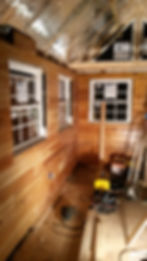
61
Second wall done!
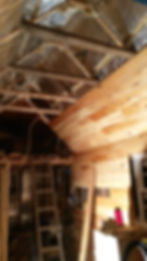
64
Up to the ceiling
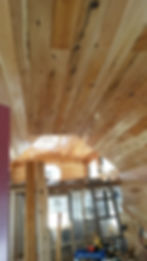
68
Loft done!
With the interior roughed in, it was time to start putting on the finishes. When I bought the frame and trailer, the previous owner had a stack of old pine boards off an old barn. Some were floor boards, some were siding, some were painted, and most had quite a few nails in them. I had originally thrown them out of the house and considered them scrap wood, but when I started to look at flooring costs, I decided to give them another look. I sanded one down, put some stain on, and it looked amazing! Flooring found! They needed a lot of work though. First, I spent 3 hours carefully inspecting each board and pulling out every single nail I could find. Then, I borrowed a planer, and planed them all down to 3/4" thick. Some of the boards only took one pass. Many of them took 3, 4, and even 5 passes, so it was a very time consuming process. With the planing done, I sanded each board with a belt sanded with 40 grit and then 80 grit sand paper. Then it was on to a handheld orbital sander with 80 grit, 150 grit, and finally 220 grit. Next, wood conditioner, stain, a coat of poly, sand with 220 grit, coat of poly, sand with 220 grit, and a final coat of poly. Very time intensive, but I am extremely happy with the results, and the price was right! I installed the bathroom floor first and then moved on to the main floor. These were all previously used boards, so the width and length of each board was different, and most of them were not straight. Needless to say, installation was a challenge. It was part jigsaw puzzle trying to find pieces that fit and part brute strength manhandling them into position. It took the better part of a day to put the floor in, but I am very happy with the results!

41
Reclaimed rough cut barn barns

41a
1/2 the nails removed from the boards
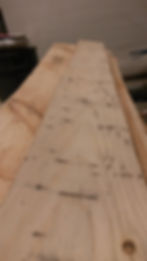
43
Boards after being planed

80
Conditioning the boards prior to staining

IMG_8368
First bit of floor installed in the bathroom

109
Laying out the floor boards

110
Playing jenga with the floor boards

111
Done!

112

IMG_8443
One of the more difficult things about the interior of the tiny house is that almost nothing is a standard size. You can't just go to Home Depot and pick out a set of cabinets and put them into a tiny house. Almost everything needs to be custom built which is either expensive or time consuming. Being the cheap guy that I am, I went the time consuming route. The kitchen cabinets were framed with 2x3 lumber, and finished with cedar T&G that I ripped/cut to size as needed. The cabinet doors & drawers were again made with a cedar frame with a 1/4" plywood center for character. Custom shelves were built for the bathroom and clothes closet. Six 20x20x20 storage boxes were built to act as the couch/chairs/additional storage. The boxes were again framed with cedar T&G that I cut/ripped into 1x1 pieces. The four sides of the boxes are 1/4" plywood and the top/bottoms are 3/8" plywood. I wanted something unique for a ladder, so when I saw some recently cut smaller hemlock trees, I saw a great opportunity! I set the logs aside, and a 8 months later de-barked them and fashioned them into a rustic folding ladder. I cut the ladder in 1/2" and put hinges on so that when not in use, the ladder can fold up and slide between the cabinets and refrigerator.
Past Posts

77
Roughing in the kitchen cabinets
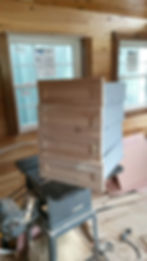
96
Kitchen drawers built
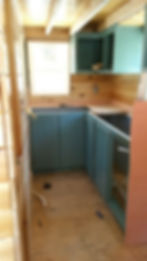
84
Cabinet doors installed and painted
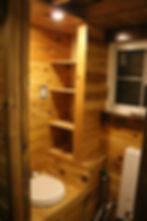
IMG_8360
Bathroom shelves

115
Clothes closet with shelves in the back

86
Frames for the storage boxes.

IMG_8372
Three hemlock trees waiting to be de-barked and turned into the ladder
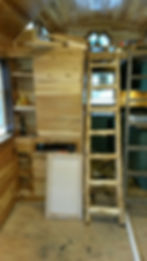
20160613_100031_resized
Ladder done
Up Next:
bottom of page




















